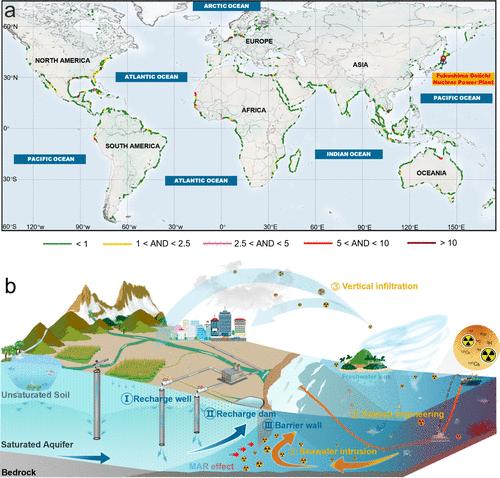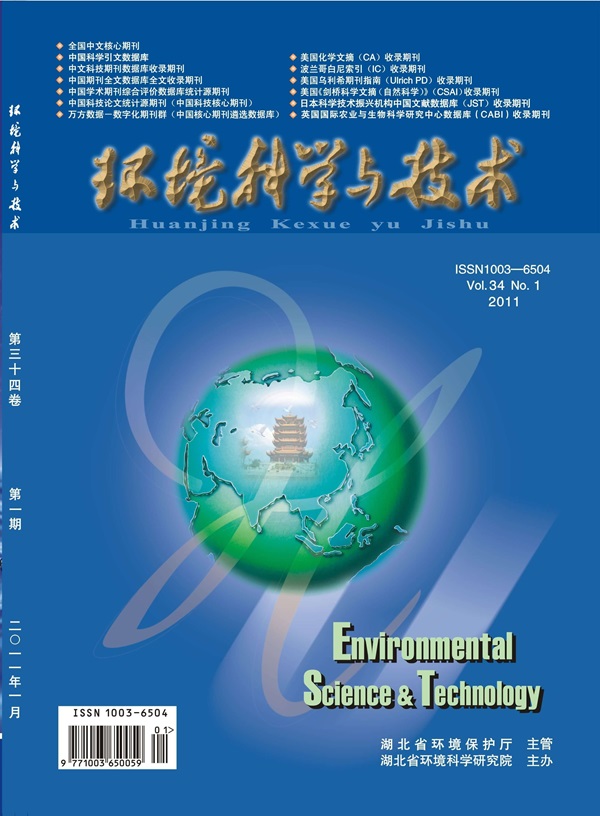福岛辐射水威胁沿海地下水
IF 10.8
1区 环境科学与生态学
Q1 ENGINEERING, ENVIRONMENTAL
引用次数: 0
摘要
图 1.在全球海水入侵的影响下,福岛放射性水对沿海地下水构成威胁。(a) 全球海水入侵导致内陆盐碱化程度加剧。根据 RCP 8.5 情景预测,到 2100 年,与 2000 年相比,盐水楔将向内陆移动(千米)。RCP 是代表性浓度路径的缩写,是用于概述未来全球温室气体排放量和浓度的框架。RCP 8.5 描述了一种高排放情景。(34)(b)放射性水对沿岸地下水威胁的途径和防护措施,包括①海水入侵、②海底 工程和③垂直渗透,这些都对沿岸地下水构成威胁,使放射性污染物通过土壤层渗 透到地下蓄水层,危及地下水质量和人类健康。(11,22,33,46) 管理战略主要围绕有管理的含水层补给 (MAR),包括补给井和补给坝,为减轻放射性水的危害提供了有效的预防措施。(47-49)此外,隔离墙可以有效削弱咸水和淡水之间的相互作用,防止海洋放射性水进入沿岸地下水。(51) Y.W.领导了构思、写作和图表起草工作。J.Z.、Z.Z.和 Y.C. 协助写作和绘制图表。X.C. 和 H.L. 构思并设计了框架。L.W.、T.-C.J.Y.、C.C.和M.X.协助改进了论文的写作。所有作者均同意论文发表。魏亚强博士现任上海大学副教授。他在上海交通大学完成博士后研究,2017年获得中国科学院大学博士学位,并在美国亚利桑那大学联合培养。他的主要研究方向是污染物在土壤和地下水中的迁移、转化和归宿。他主持了多项研究项目,包括国家自然科学基金重点基金项目和青年基金项目,以及国家重点研发计划 "土壤污染成因与控制技术 "的两个子课题。他还担任《生态环境与amp》、《健康与农业通讯》等期刊的青年编委。李辉,上海大学环境与化学工程学院正教授。他是国家杰出青年科学基金获得者,并担任国家重点研发计划首席科学家。他主持了 20 多项国家和省级重点科研项目。长期从事环境行为学、生态毒理学、污染物修复技术、碳峰与碳中和实现路径等多学科研究。本文得到国家自然科学基金(42107015、42330706 和 42125706)的资助。本文引用了 51 篇其他出版物。本文尚未被其他出版物引用。本文章由计算机程序翻译,如有差异,请以英文原文为准。

Fukushima’s Radioactive Water Threatens Coastal Groundwater
Figure 1. Fukushima radioactive water poses a threat to coastal groundwater under the impact of global seawater intrusion. (a) Global seawater intrusion results in a heightened degree of inland salinization. By the year 2100, the inland shift (kilometers) of the saline water wedge, in comparison to the year 2000, is forecasted on the basis of the RCP 8.5 scenario. RCP, which stands for a representative concentration pathway, is a framework employed to outline future global greenhouse gas emissions and concentrations. RCP 8.5 delineates a high-emission scenario. (34) (b) Pathways and protection measures for the threat of radioactive water on coastal groundwater, including ① seawater intrusion, ② subsea engineering, and ③ vertical infiltration that pose threats to coastal groundwater by allowing radioactive contaminants to seep through soil layers and reach underlying aquifers, jeopardizing both groundwater quality and human health. (11,22,33,46) The management strategy mainly revolves around managed aquifer recharge (MAR), which includes recharge wells and recharge dams, offering effective preventive measures to mitigate the harm of radioactive water. (47−49) Additionally, barrier walls can effectively weaken the interaction between saltwater and freshwater, preventing marine radioactive water from entering coastal groundwater. (51) Y.W. led the conceptualization, writing, and figure drafting. J.Z., Z.Z., and Y.C. assisted with writing and figures. X.C. and H.L. conceived the ideas and designed the framework. L.W., T.-C.J.Y., C.C., and M.X. helped to improve the writing of the paper. All authors approved publication. Dr. Yaqiang Wei is currently an Associate Professor at Shanghai University. He completed his postdoctoral research at Shanghai Jiao Tong University and obtained his Ph.D. degree from the University of Chinese Academy of Sciences in 2017, with a joint training program at the University of Arizona, United States. His primary research focus is on the migration, transformation, and fate of contaminants in soil and groundwater. He has led several research projects, including a project of key fund and a Youth Fund from the National Natural Science Foundation, and two subprojects under the National Key Research and Development Program for Soil Pollution Causes and Control Technologies. He also serves as a young editorial board member for journals such as Eco-Environment & Health and Agriculture Communications. Hui Li is a full professor at the School of Environmental and Chemical Engineering, Shanghai University. He is the recipient of the National Science Fund for Distinguished Young Scholars and serves as the Chief Scientist of the National Key Research and Development Program. He has led more than 20 national and provincial key scientific research projects. He has been engaged in multidisciplinary research on environmental behavior, ecotoxicology, remediation technologies of pollutants, and realization path for carbon peak and carbon neutral. This work was supported by the National Natural Science Foundation of China (42107015, 42330706, and 42125706). This article references 51 other publications. This article has not yet been cited by other publications.
求助全文
通过发布文献求助,成功后即可免费获取论文全文。
去求助
来源期刊

环境科学与技术
环境科学-工程:环境
CiteScore
17.50
自引率
9.60%
发文量
12359
审稿时长
2.8 months
期刊介绍:
Environmental Science & Technology (ES&T) is a co-sponsored academic and technical magazine by the Hubei Provincial Environmental Protection Bureau and the Hubei Provincial Academy of Environmental Sciences.
Environmental Science & Technology (ES&T) holds the status of Chinese core journals, scientific papers source journals of China, Chinese Science Citation Database source journals, and Chinese Academic Journal Comprehensive Evaluation Database source journals. This publication focuses on the academic field of environmental protection, featuring articles related to environmental protection and technical advancements.
 求助内容:
求助内容: 应助结果提醒方式:
应助结果提醒方式:


